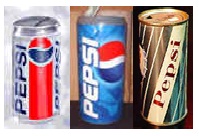Sugar Analysis Experiment
An Experiment to Analyse the presence of Monosaccharide, Disaccharide and Polysaccharide Sugars.
 You are working as a biochemist for a rival soft drinks company and you need to find out which sugars are used in the new recipes for three Pepsi products. “Pepsi Mix”, “Pepsi Max”, “Pepsi Mox”.
You are working as a biochemist for a rival soft drinks company and you need to find out which sugars are used in the new recipes for three Pepsi products. “Pepsi Mix”, “Pepsi Max”, “Pepsi Mox”.
You have acquired samples of the drinks and one of your colleagues has decolourised the samples.
The task is to find out which sugar is used in each drink. You have to test the sugars using Iodine and Benedict's solution.
Lesson Description
Guiding Questions
Which sugar is used in each sample of Pepsi drink.
How can we use Benedicts Reagent and an understanding of the difference between monosaccharides and disaccharides to find out?
Activity 1 - Analysis of sugars experiment
Follow the instructions on the ![]() Pepsi sugar analysis experiment worksheet to test the different samples of drinks.
Pepsi sugar analysis experiment worksheet to test the different samples of drinks.
Activity 2 - Extension reading
Harvard School of Public Health - Names of sugars used in food
Teachers notes
The experiment is well explained on the worksheet. The students are asked to believe the scenario that they are really testing drinks to identify the sugars they contained.
It is not really suitable for IA but it is a good exercise in manipulative skills, and measuring volumes, temperatures and timings. It also gives students a reason for understanding the differences between the three different groups of sugars.
The colour changes are not rapid, and the question of identifying end points, and precise colours can be discussed.
Solutions can be cooled in ice water and stored for later comparison as the colour only changes slowly at low temperatures. If the solutions are left in the water bath at 80°C they will continue changing.
Extension Experiment- Using Enzymes to Test the way the Pepsi drinks will react in the Mouth.
Will the drinks change their taste while they are in your mouth?
We can test this using the enzyme amylase which is normally found in saliva. If it breaks down the sugar then the drink will become sweeter as the sugar is breaking down.
Does amylase break the bonds between the glucose molecules in the maltose, or the bonds in the disaccharide sucrose molecules?
Does it break down the polysaccharide starch into glucose or maltose?
- Add 2ml of amylase enzyme to the "Pepsi" drinks and put in a water bath at 40oC for 5-10 minutes.
- Retest the enzyme digested drinks with the Benedict's and Iodine.
- Record your results in your results table.
- Write a conclusion of your findings, point out any errors in the results
- Evaluate the experiment for accuracy etc.
Technician's note
The Recipes for the sugar samples are:
- Sample of Pepsi MIX, 1dm3 = water coloured lightly with tea containing 20g sucrose
- Sample of Pepsi MAX 1dm3 = warm water coloured lightly with tea containing 20g starch & left to cool
- Sample of Pepsi MOX 1dm3 = water coloured lightly with tea containing 20g glucose
Each group of students will need the following apparatus:
- Dropping pipettes
- Measuring cylinder
- Benedict's Reagent (dropping bottle)
- Iodine Solution (dropping bottle)
- Water bath set to 80°C
- Stopwatch
- Dilute solutions of sucrose, glucose, starch, maltose (for testing)
- Sample of Pepsi MIX, 100ml
- Sample of Pepsi MAX 100ml
- Sample of Pepsi MOX 100ml
Possible alternative approach - giving a TOK example of objects for the Exhibition.
At the beginning of this lesson students could think about the origin of cells, and emergent properties from topic 1.
If this video is shown
students can see an experiment where the theory of vitalism was challenged. The video mentions simple molecules building into bigger molecules, polymers and then forming cells. This sugars experiment includes mono di and poly saccharides which follows the step by step evolution of complexity.
A link to TOK could be included, and some objects, like a Bunsen burner, a round bottom flask, or even a photo of the apparatus used by Millar and Urey. These can help to illustrate points around the TOK knowledge prompts:
11. Can new knowledge change established views and beliefs,
23. How important are material tools in the production or acquisition of knowledge, or
5. What counts as good evidence for a claim.
4. On what grounds might we doubt a claim?
There are some interesting documents for further reading in this BioTechSquad blog post, including the original paper.
Note: This activity could be positively framed as a research into 'copycat' production of a soft drink, to test if the recipie is the same as the genuine drink, or not.

 IB Docs (2) Team
IB Docs (2) Team
